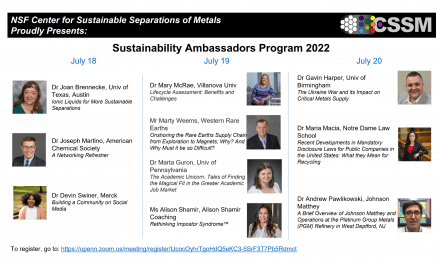Congratulations to CSSM members and affiliates on the latest publication, titled “Selective Reduction of Niobium(V) Species to Promote Molecular Niobium/Tantalum Separation” in Inorganic Chemistry!
The critical metals niobium (Nb) and tantalum (Ta) coexist in mineral sources, requiring a separation step to purify the elements from one another. The industrial separation process by solvent extraction uses stoichiometric hydrofluoric acid to manifest differences in the speciation of these otherwise chemically similar elements. The identification of alternative methods to separate Nb/Ta is desirable for fluoride waste reduction. In pursuit of this goal, the novel complexes [Na(CH3CN)3(Et2O)][M((S)-BINOLate)3] [M = Nb (1-Nb), Ta (1-Ta)] were synthesized and characterized. In electrochemical studies, a reduction event at the potential −2.04 V versus ferrocene/ferrocenium was observed for 1-Nb, whereas 1-Ta exhibited no metal-based waves in the electrochemical window. In addition to the inherent 4d/5d orbital energy differences between Nb/Ta, density functional theory calculations suggest a larger degree of π donation from the ligands to the metal cation in 1-Ta compared to 1-Nb, destabilizing the lowest unoccupied molecular orbital. This phenomenon contributes to a calculated reduction potential difference of ca. 0.75 V, allowing for the selective reduction of 1-Nb and separation of the reduction product through leaching with diethyl ether for a separation factor of 6 ± 2.

Please check out the manuscript at: https://pubs.acs.org/doi/10.1021/acs.inorgchem.1c02976





